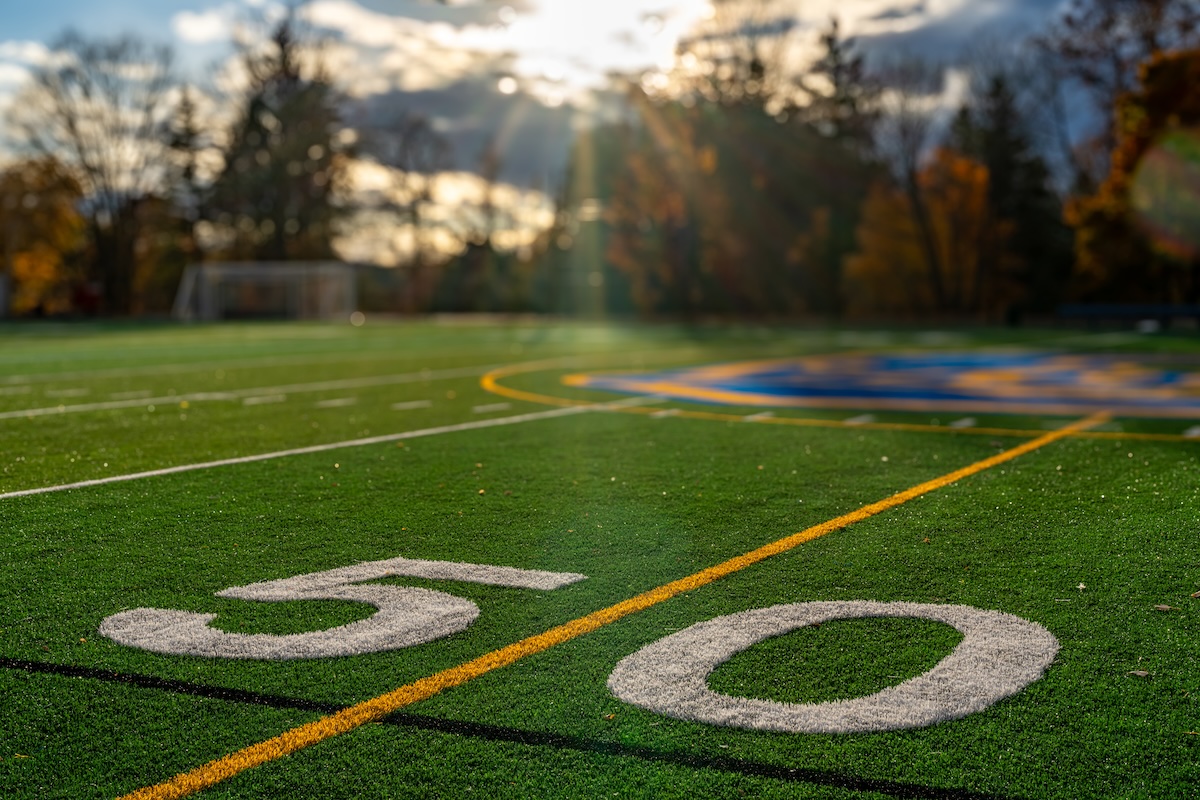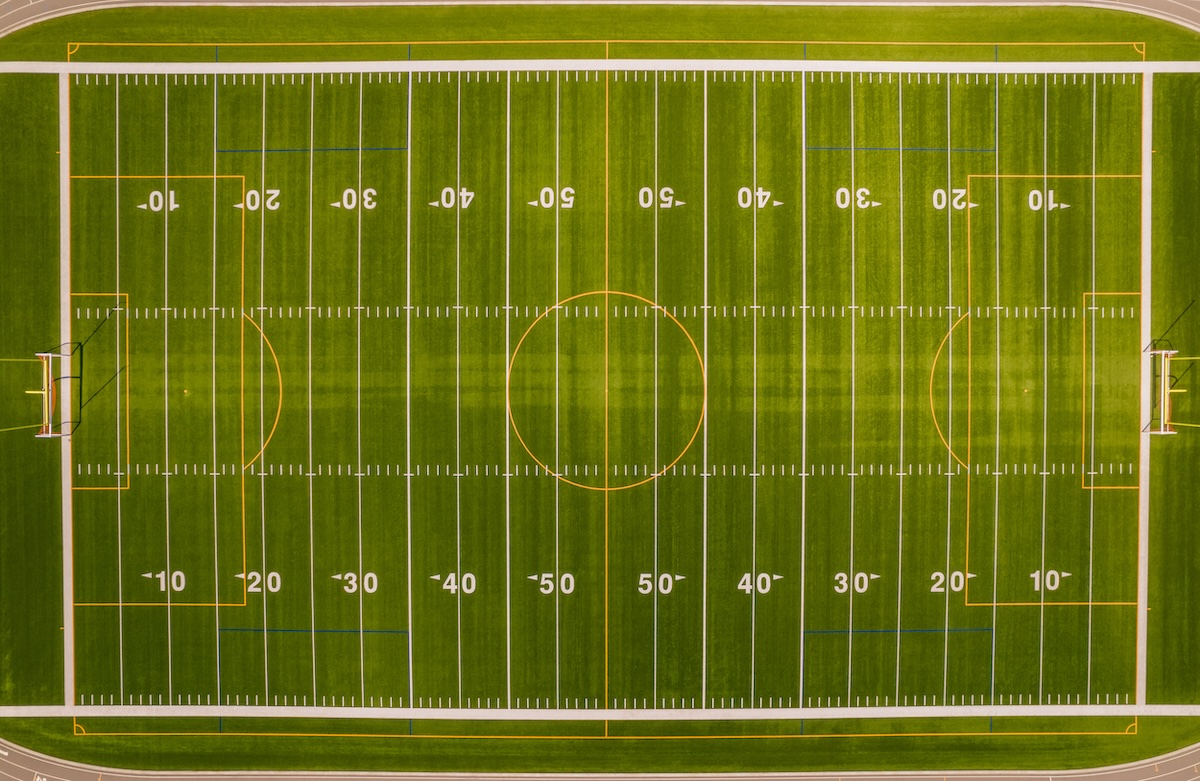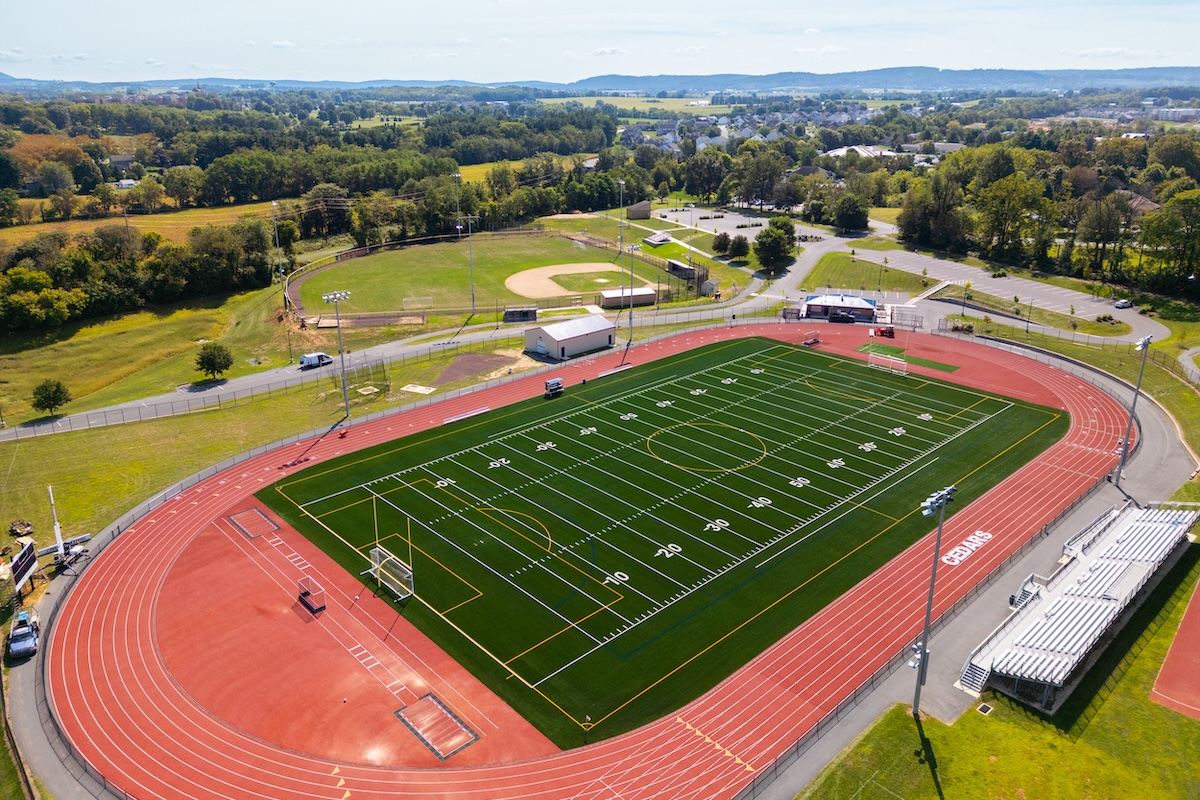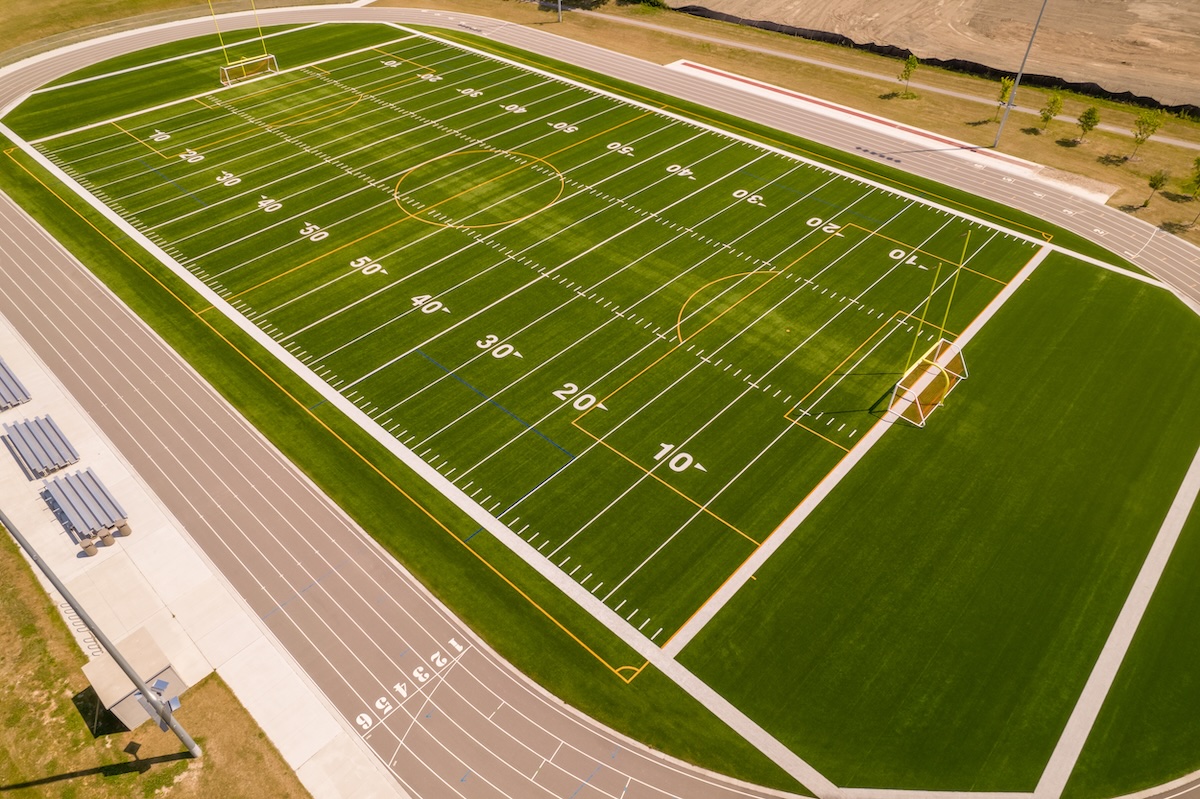Last Updated on November 4, 2025 by UDC Sports
When a school decides it’s time to upgrade its athletic facilities, one of the first questions that comes up isn’t about turf or lighting—it’s space. Specifically, how to make one field do the job of several. The football team wants more practice time. Soccer needs game-quality footing. PE classes still need room to move, and if you’re lucky enough to have lacrosse or track programs, they’ll want their share too.
It’s a lot to ask of one rectangle of grass or turf, but that’s exactly what many school sports field construction projects call for: a single, reliable, all-season field or small stadium that can handle activities throughout the week and still look good on Friday night.
That said, the challenge isn’t simply squeezing more sports onto the same patch of ground—it’s making that space work for everyone who uses it. The field has to handle hot afternoons, cold snaps, and quick turnarounds between events without falling apart. It’s often the most-used spot on campus, and every choice—how the base is graded, where the lights go, how the water drains—ends up affecting more people than you’d think.
That’s why good sports facility design and construction starts with understanding how the field fits into everyday life at the school. It’s where PE classes happen, where soccer runs drills after the bell, and where the band finishes practice right before football warms up. It’s not one team’s field—it’s everyone’s. And when it’s built to handle that kind of shared use, it holds up better, plays better, and makes life easier for the people trying to keep it ready all season long.

For athletic directors, facility managers, and school leaders, that’s what success looks like—not just a field that photographs well on opening day, but one that stays safe, durable, and ready for whatever the schedule throws at it. When the design gets that right, the investment pays back in fewer repairs, smoother seasons, and a better experience for every athlete and spectator who uses it.
Starting with the Big Two: Football and Soccer
Many simple multi-sport field layouts start and end with these two. Football dominates the calendar—fall Fridays, summer practices, and spring conditioning—and the constructed athletic field is almost always measured and marked around its 120-yard footprint (that’s 100 yards of play plus the end zones). Now, on the other hand, soccer overlaps in both season and space, running up to 120 yards long as well, but sometimes a little wider depending on the rules and age group. The overlap looks tidy on paper, but in practice it’s a dance of measurements and compromises.
For example: Football’s hash marks are fixed at 53⅓ yards apart, while soccer fields can stretch to 75 or 80 yards. That means you’ll need to decide early how far you’re willing to push those sidelines toward the fence or track. Too tight, and soccer players run out of breathing room near the benches; too wide, and the goalposts start to feel crowded by fencing or spectator areas. Those few yards of space can change everything from where drainage lines go to how bleacher footings are poured.
 Even the goals themselves are important. Permanent football uprights can stay in place year-round, but soccer goals are usually portable. Designing the sleeves or anchors for those goals right into the base layer saves you from having to drive stakes into expensive turf later on. It’s one of those small decisions that doesn’t seem like a big deal—until you’re watching someone hammering rebar into a brand-new field because there wasn’t a plan for goal anchors. When the details come together like that, the whole layout just works better. Setup takes minutes instead of hours, the maintenance crew isn’t improvising fixes, and every program using the field can focus on play instead of patchwork.
Even the goals themselves are important. Permanent football uprights can stay in place year-round, but soccer goals are usually portable. Designing the sleeves or anchors for those goals right into the base layer saves you from having to drive stakes into expensive turf later on. It’s one of those small decisions that doesn’t seem like a big deal—until you’re watching someone hammering rebar into a brand-new field because there wasn’t a plan for goal anchors. When the details come together like that, the whole layout just works better. Setup takes minutes instead of hours, the maintenance crew isn’t improvising fixes, and every program using the field can focus on play instead of patchwork.
Beyond Football and Soccer
Designers often adapt the same field for more than one lineup—football and lacrosse, soccer and field hockey, even track sharing an interior turf. Each combination has its quirks, but the principles stay consistent: protect the surface, plan for overlapping markings, and manage drainage so every team can use it safely.
Other Common Multi-Sport Field Combinations
Once the football and soccer layout is mapped out, most schools realize they’re not the only programs sharing that space. Track, lacrosse, baseball, and even marching band all have their turn on the calendar. Each adds its own set of design quirks and maintenance pressures. Some combinations overlap naturally, while others take more coordination to make work.
Below are some of the most common activity pairings seen across U.S. school and municipal fields—and a few use-specific notes about what it takes to make each one function smoothly:
| Common Multi-Sport Combination | Why It’s Common | Design & Maintenance Challenges | Typical Solutions / Notes |
|---|---|---|---|
| Football + Soccer | Most high schools use a single rectangular field for both sports, maximizing field use across fall and spring. | Different field widths and goal areas; overlapping markings; wear concentrated in midfield zones. | Use permanent football markings with lighter soccer inlays; anchor portable soccer goals; plan drainage for dual-season use. |
| Football + Soccer + Lacrosse | Most common three-sport setup on synthetic turf; all share similar field dimensions and footprint. | Goal-crease overlap, line density, and scheduling across fall and spring seasons. | Color-coded lines by sport; lacrosse goals set in sleeves; defined rotation to avoid overuse. |
| Football + Track & Field | Classic “stadium layout” for most U.S. schools, combining football infield with a surrounding running track. | Space limits for sidelines; drainage between track and turf; event overlap during meets. | Use curb and trench drains at track edge; design safe run-off zones; locate long jump and throws in outer corners. |
| Soccer + Track & Field | Efficient footprint for schools prioritizing soccer; track surrounds a regulation-length pitch. | Reduced field width; turf and track must drain separately; limited sideline access. | Design with slightly narrower soccer field; include separate track drainage system and pedestrian paths. |
| Soccer + Field Hockey | Common in Northeastern and Mid-Atlantic states; both require smooth, fast surfaces. | Line confusion; different preferred turf pile heights; heavy goal-mouth wear. | Short-pile turf compromise; clear contrast lines; reinforced goal areas for durability. |
| Baseball + Softball (Shared Outfield) | Typical for land-limited schools and park systems; overlapping or offset diamonds reduce acreage. | Conflicting drainage patterns; outfield wear; infield mix contamination from shared use. | Offset field layout; separate infield materials; coordinated scheduling to prevent overlap. |
| Football + Marching Band / PE | Nearly universal use pattern; athletic fields double as performance and class spaces. | Sideline wear from band formations; equipment traffic; added irrigation and access needs. | Reinforced sideline turf; access pads for carts; storage and electrical planned near field entrances. |
| Football + Rugby | Growing use in private schools and universities; compatible rectangular field dimensions. | Rugby is longer and slightly wider; conflicting goalpost positions; higher surface impact. | Extend field length where possible; use removable posts; plan turf density for high contact zones. |
Multi-Sport Field Design & Construction Tips
Layering Sports Field Markings
If you’ve ever seen a multipurpose field with three sets of lines crossing each other like spaghetti, you already know how quickly things can get out of hand. Good sports field design minimizes unnecessary visual noise. It’s important to plan your line colors and paint types before installation, rather than once the turf is down.
Synthetic Turf Line Inlays
Many synthetic systems now allow permanent inlays for football, with secondary sports (soccer, lacrosse, field hockey) added in lighter contrast tones or removable paints.
It’s important to focus on clarity: players should never have to hesitate about which lines define the field they’re on. (That’s easier said than done when you’ve got 8th-grade PE, JV football, and varsity soccer all rotating through the same space in a single week!)
Not long ago, that kind of precision was mostly trial and error. Crews relied purely on tape measures, paint, and a good eye to make sure lines lined up correctly from season to season. Every re-stripe risked confusion or uneven spacing. Now, with design software and digital layout tools, fields can potentially be planned to the inch before a single roll of turf goes down. Designers can visualize every color and boundary in advance, spotting conflicts that would’ve taken years to notice in the past.
Today, athletic field designers might mock up a full layout in CAD first, complete with all intended sports, and then look at it visually to see what pops too hard or fades too much under stadium/field lighting. Those details don’t show up on spec sheets, but they make a huge difference in how usable the field feels once the games start.
Digital Field Layout Planning
Whether it’s full CAD modeling or basic layout software, the idea’s the same—see how the lines interact, catch spacing issues early, and make sure the final design reads clearly under stadium lights.
Building a Sports Surface That Holds Up to Heavy Use
A multi-sport field doesn’t get many breaks. Football games chew up the middle of the field, soccer grinds the goal boxes, and every practice brings its own set of wear patterns. That’s a big part of why so many schools lean toward synthetic turf once the calendar starts stacking up.
It’s not because anyone necessarily dislikes natural grass—it’s because living grass just doesn’t recover fast enough between uses. (And let’s be honest, what most people dislike isn’t grass itself, it’s the ongoing maintenance bills that come with keeping it alive. Between irrigation, fertilizer, paint, and labor hours, a natural surface starts feeling pretty expensive once the season ramps up.) When that same field hosts games or events 4 or 5 days a week, there’s no downtime to re-seed, roll divots, or rest the surface.

Grass still has its place, though—especially for schools with lighter schedules or dedicated maintenance crews who know how to care for it. A natural surface can look and play beautifully when it’s managed well, and some coaches still prefer the feel of it underfoot. But the reality is that most school calendars don’t leave much recovery time. Once a field is expected to handle daily use, community events, and weather extremes, even the best-kept grass starts to fall behind. That’s usually when conversations about grass versus artificial turf stop being about preference and start being about practicality.
Designing the subsurface right is what keeps the whole system from failing. That means starting with accurate grading—typically around a one-percent crown from the center out, depending on the drainage spec—and a stone base engineered to move water away from high-traffic zones. Synthetic systems can be built either over free-draining aggregate with perforated piping or over a full-panel drainage grid that channels runoff more uniformly. Both can work, but skipping either one isn’t an option if you expect the field to last more than a few seasons without headaches.
Keeping a Manageable Schedule
Every coach dreams of a field that’s “always open,” but the fact is, there has to be a schedule. Even synthetic turf benefits from downtime. The fibers need to stand back up, the infill needs grooming, and maintenance crews need windows to repair seams or adjust compaction.
When you’re designing a multi-sport field, part of that design is logistical—setting expectations for how many hours of play per week the surface can safely handle. Schools that plan early for that rotation—football Monday through Thursday afternoons, soccer after 5:00, PE during mornings—find it easier to maintain field quality. Those that try to squeeze in everyone, every day, end up with early wear spots that shorten the lifespan of the surface and increase replacement costs down the road.
Scheduling helps control both wear and cost. When a field gets used nonstop, small problems like compaction or uneven footing turn into repairs that come sooner and cost more than they should. Building in recovery time keeps the surface consistent and the maintenance budget stable.
Practice and Game Rotation
A defined rotation for practices and games keeps both the field and the budget in better shape. When a single surface is expected to handle football, soccer, PE, and marching band rehearsals all in one week, the wear patterns show fast. Rotating who uses the field and when—by day, time slot, or season—spreads out the load evenly across the surface.
That rotation gives maintenance crews predictable windows to groom turf, manage infill, or rest grass sections without disrupting play. It also keeps scheduling conflicts from turning into repair costs. Over time, fields with structured usage plans maintain safer footing, more consistent playability, and longer replacement cycles.
Post-Game Wrap-Up
 At the end of the day, a multi-sport field has to work in the real world—under Friday night lights, on a muddy Tuesday morning, and through every practice in between. It’s getting the slope right, keeping drainage where it belongs, and making sure the surface holds up when every team on campus needs it at once. When the design gets that balance right, a single field can essentially be the backbone of the entire athletic program.
At the end of the day, a multi-sport field has to work in the real world—under Friday night lights, on a muddy Tuesday morning, and through every practice in between. It’s getting the slope right, keeping drainage where it belongs, and making sure the surface holds up when every team on campus needs it at once. When the design gets that balance right, a single field can essentially be the backbone of the entire athletic program.
A multi-sport field succeeds when it feels effortless to use, even when it’s packed with activity. Thoughtful design and planning up front can help keep it that way for many seasons to come.


